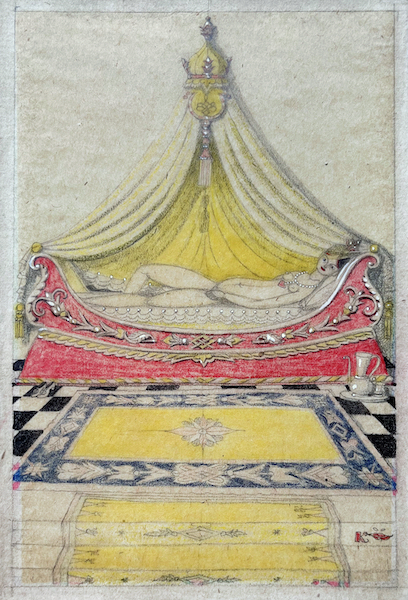Biography
Lajos Kozma (born Lajos Fuchs) was an architect, industrial artist and graphic designer, university professor. He is an outstanding master of Hungarian Art Nouveau graphics and modern architecture and furniture design.
He was the son of Gyula Fuchs and Ida Fleiner. As a child, he attended an elementary school patronized by Henrik Marczali in Marcali (1890–1894), then continued his education in Kaposvár. Between 1902 and 1906 he studied at the József Királyi University of Technology. His teacher was Béla Jánszky. In 1909-1910, he studied painting with Henri Matisse in Paris as a scholarship recipient. He was a member of the intellectual circle of young architects with a folk art nouveau style, formed following the aspirations of Károly Kós - Society of Youth. Together with Károll Kós, Dénes Györgyi, Béla Jánszky and others, they tried to realize a modern, at the same time, national architectural art. The decorative motifs of folk architecture and pastoral carving were collected from the landscapes of Somogy County and Transylvania. They made sketches, drawings, and engravings of the village buildings, churches, and gates and incorporated these style features into their designs.
Between 1910 and 1913, he managed Béla Lajta's design office. In 1911, he appeared at the KÉVE exhibition with his graphics, illustrations and furniture designs. The Rózsavölgyi house, which was built based on Lajta's plans and has since been destroyed, carried out the Biedermeier interior design works in 1912. That's when his industrial art work started. The exterior decoration of other Lajta buildings – Erzsébetvárosi Bank, Vas Street School – is also associated with his name. He also made utility and furnishing items for the New York palace.
In 1913, he became a teacher at the School of Industrial Design and founded the Budapesti Műhely, which aimed to reform the art of housing. His furniture designs became a concept in the 1920s under the name "Kozma-baroque", he was awarded the Grand Gold Medal of Applied Arts for his furniture in 1925, but his style already pointed in the direction of art deco. In 1919, due to financial difficulties, he left the company and continued as an independent designer.
During the time of the Hungarian Soviet Republic, he was a member of the Art Directorate, and then he was appointed a teacher of the Department of Interior Design at the University of Arts in 1919. However, he lost this post with the fall of the commune.
His graphic work was also significant, at the beginning of his career he created book illustrations. (Utolsó ábrándok, 1908, Ady illustrations, Géza Csáth, Zsigmond Móricz book covers, etc.) He established a close relationship with the famous Kner printing house in Gyoma, where he designed Art Nouveau book graphics (Kner Klasszikusok, Monumeta Litterarum). In 1925, he designed Imre Kner's residence in Gyomá, in art deco style, which is now the Printing Industry Museum.
In the 1930s, he increasingly turned to building design. In 1930, he planned the reconstruction of the Magyar Divatcsarnok, and later built several tenements. Most of his carefully designed family houses and villas with a clean design were built in the second district of Budapest. These already show a connection to the avant-garde (Bauhaus). (39–67 Bimbó Street, 19 Berkenye Street, 10 Csopaki Street, 10 Hermann Ottó Street, 6–8 Napraforgó Street, 13 Trombitás Street, etc.). His most significant works: the Átrium house, the Margit krt. 55 below, with a movie theater on its lower levels. As well as the V. district, Vadász utca, the so-called Glass House, which was originally built as a commercial and warehouse building, today there are mostly apartments in the building, and it bears little resemblance to the original plans. One of his best-known works is a holiday home on Lupa Island, which he designed based on his own model. At the twice-yearly Budapest International Fairs, he designed a number of modern, experimental pavilion buildings: Magyar Ház (1932–33), Tower of the Textile Pavilion, Tourist Pavilion (1936), Textile Pavilion (1937) Pavilion of Magyar Lajos Gépszíj és Bőrárugýár Rt. (1939, 1940) Tungsram- pavilion, Weiss Manfréd Steel and Metal Co. pavilion (1940) Tungsram – Orion "Pavilion of light" (1941).
In 1941, in Switzerland, his book Das neue Haus was published, in which he not only published his already completed buildings, but also presented a number of blueprints with a new spirit. His last significant work, the elementary school building designed for the corner of Gyöngyösi and Ránky streets, was completed after his death in 1949.
From 1945, he was a member of the Architectural Arts Council of the Hungarian Arts Council and the Metropolitan Public Works Council, and from 1946 he was a teacher and director of the College of Applied Arts. In 1947, he got his chair back at the University of Technology, but soon after that he fell ill and was unable to enjoy his new position. He was the president of the New Architecture Circle, created in 1946 and bringing together left-wing architects. The most significant work of the circle was the Új Csepel exhibition, which opened in 1948 at the National Salon. Kozma was featured in the exhibition with the design of the elementary school in Csepel. He died on November 26, 1948, in Budapest.

